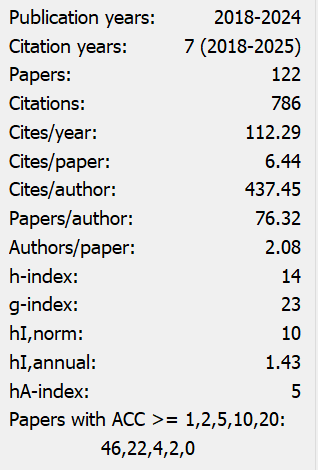Innovation Spillovers from Core Enterprises' Digital Transformation: Evidence from Client-Supplier Relationships
Abstract
Drawing upon supply chain data from Shanghai and Shenzhen A-share listed companies between 2007 and 2022, this study examines the impact of core enterprises' digital transformation on suppliers' innovation. Findings reveal that digital transformation in core enterprises stimulates suppliers' innovation, with a stronger effect on substantive innovation than on strategic innovation. Mechanism analysis indicates that core enterprises' digital transformation primarily drives supplier innovation through financial spillovers, knowledge spillovers, and innovation facilitation. Heterogeneity analysis reveals that the promotional effect is more pronounced when client-supplier relationship dependency is low, suppliers operate in high-tech industries, and suppliers are non-state-owned enterprises. Adopting a supply chain perspective, this study refines the existing research on client enterprises' digital transformation influencing supplier innovation, offering insights for advancing corporate innovation and fostering collaborative innovation within supply chains.
References
[2] Li, X., Dang, L., & Zhao, C. (2022). Digital transformation, integration into global innovation networks, and innovation performance. China Industrial Economics, (10), 43-61.
[3] Zhao, C., Wang, W., & Li, X. (2021). How digital transformation affects firm total factor productivity. Finance and Trade Economics, 42(7), 114-129.
[4] Wu, F., Hu, H., & Lin, H., et al. (2021). Corporate digital transformation and capital market performance: Empirical evidence from stock liquidity. Management World, 37(7), 130-144.
[5] Sun, Z., & Lu, R. (2023). Research review and outlook on corporate digital transformation. Journal of Capital University of Economics and Business, 25(6), 93-108.
[6] Yang, Z., & Chen, J. (2024). The driving mechanism of corporate digital transformation: A perspective from female executives. Research in Economics and Management, 45(3), 109-124.
[7] Wang, H., Yan, Z., Guo, G., & Yin, J. (2023). Digital infrastructure policies and corporate digital transformation: "Empowering" or "disempowering"? Journal of Quantitative Economics and Technical Economics, 40(5), 5-23.
[8] Du, C., Wang, C., & Guo, S. (2023). The impact of government innovation subsidies on the digital transformation of manufacturing enterprises. Fiscal Research, (12), 69-82.
[9] Fan, J., & Wan, H. (2024). Does trade friction promote corporate digital transformation?: Micro evidence from Chinese manufacturing listed companies. World Economy Research, (3), 120-134.
[10] Qiu, Y., Wang, Z., & Jiang, Y. (2024). Can digital transformation reduce corporate capital costs? Theory and Practice of Finance and Economics, 45(1), 83-90.
[11] Lü, K., Yu, M., & Ruan, Y. (2023). Corporate digital transformation and resource allocation efficiency. Science and Technology Management, 44(8), 11-20.
[12] Zhai, H., Yany, M., & Chan, K. C. (2022). Does digital transformation enhance a firm's performance? Evidence from China. Technology in Society, 68, 101841. https://doi.org/10.1016/j.techsoc.2021.101841
[13] Wang, B., & Kang, Q. (2023). Digital transformation and corporate sustainable development performance. Economic Management, 45(6), 161-176.
[14] Dai, X., Li, Y., & Chen, K. (2020). Direct demand-pull and indirect certification effects of public procurement for innovation. Technovation, 101, 102198. https://doi.org/10.1016/j.technovation.2020.102198
[15] Liu, H., Chen, M., & Jiao, W. (2023). The impact of "deleveraging" policies on innovation efficiency in state-owned enterprises: Suppression or promotion? Economic Management, 45(11), 68-88.
[16] Wu, J. G., Mao, J., & Tang, C. (2022). Do government R&D subsidies incentivize innovation in technology-based SMEs? China Soft Science, (9), 184-192.
[17] Zhang, L., Qiu, B., & Wu, L., et al. (2024). Human capital accumulation, trade liberalization, and innovation in Chinese manufacturing enterprises. Economics Quarterly, 24(2), 379-394.
[18] Li, J., Zhang, J., & Dong, X. (2022). How does the digital economy affect corporate innovation capabilities: Internal mechanisms and empirical evidence. Economic Management, 44(8), 5-22.
[19] Tian, L., Wang, K., Ma, J., & Yu, D. (2022). The impact of industry-finance integration on corporate innovation: Resource synergy or resource curse? Economics (Quarterly), 22(6), 1891-1912.
[20] Xin, J., Cai, J., & Yang, C., et al. (2023). Business environment, financing structure, and innovation investment in family enterprises. Science and Technology Management, 44(1), 56-65.
[21] Wang, S., Wen, X., & Liu, J. (2023). The impact of Fintech on innovation in small and medium-sized enterprises. Economic Issues, (3), 51-57.
[22] Gao, L., & Zhao, Y. (2023). Mixed ownership with multiple heterogeneous major shareholders and corporate innovation: Mediating effects of risk-taking and financing constraints. Management Review, 35(11), 126-141.
[23] Wang, X., & Sun, M. (2023). Key executive pay gaps, risk preferences, and corporate innovation: Empirical evidence from high-tech enterprises. East China Journal of Economics and Management, 37(2), 42-52.
[24] Li, Y., Liu, Y., & Xie, F. (2019). Technology directors and firm innovation. Journal of Multinational Financial Management, 50, 76-88. https://doi.org/10.1016/j.mulfin.2019.04.001
[25] Shi, L., & Peng, Z. (2024). The impact of corporate digital transformation on innovation efficiency: An analytical framework based on the Schumpeterian innovation paradigm. Chinese Rural Economy, (4), 99-119.
[26] Li, Y., Lan, Q., & Wu, W. (2022). Research on supply chain diffusion mechanisms in customer companies' digital transformation. China Industrial Economics, (12), 146-165.
[27] Zhang, T., & Li, L. (2024). Supply chain spillover effects of corporate digital transformation: A dual perspective of customers and suppliers. Science and Technology Progress and Policy. Advance online publication.
[28] Liu, S., Wen, X., & Chen, X. (2023). Supplier digitalization and downstream customer production efficiency: A supply chain spillover effect perspective. East China Journal of Economics and Management, 37(8), 23-32.
[29] Li, Q., Li, Y., & Zhang, Y., et al. (2023). Information spillover effects of corporate digital transformation: Empirical evidence from a supply chain perspective. China Industrial Economics, (7), 142-159.
[30] Qi, H., Wei, Y., & Liu, Y. (2022). Corporate digital transformation and commercial credit supply. Economic Management, 44(12), 158-184.
[31] Yuan, C., Xiao, T., Geng, C., & Sheng, Y. (2021). Digital transformation and corporate division of labor: Specialization or vertical integration. China Industrial Economics, (9), 137-155.
[32] Tian, X., & Wang, T. Y. (2014). Tolerance for failure and corporate innovation. Review of Financial Studies, 27(1), 211-255. https://doi.org/10.1093/rfs/hhr130
[33] Li, W., & Zheng, M. (2016). Substantive innovation or strategic innovation?—The impact of macro industrial policy on micro enterprise innovation. Economic Research Journal, 51(4), 60-73.
[34] Yang, J., Peng, Q., & Ge, Z. (2022). Customer contagion effects in digital transformation: A supplier innovation perspective. China Industrial Economics, (8), 156-174.
[35] Wang, T., & Liu, D. (2025). The impact of financing constraints on corporate innovation efficiency: Based on the moderating effects of digital finance and internal control. Research on Science and Technology Management, 45(7), 77-85.
[36] Guan, X., & Li, F. (2025). Digital transformation, supply chain spillovers, and corporate innovation. Research on Economics and Management, 46(5), 107-124.

This work is licensed under a Creative Commons Attribution 4.0 International License.
Copyright for this article is retained by the author(s), with first publication rights granted to the journal.
This is an open-access article distributed under the terms and conditions of the Creative Commons Attribution license (http://creativecommons.org/licenses/by/4.0/).


























